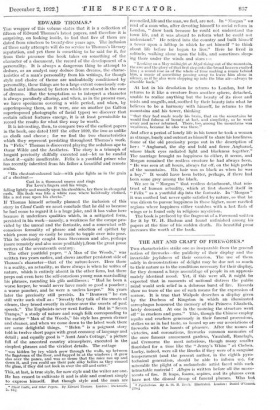THE ART AND CRAFT OF FIREWORKS.* Two characteristics strike one
as inseparable from the general notion of fireworks—the publicity of their display and the invariable joyfulness of their occasion. The use of them solely in demonstrations of delight may be due not so much to their nature as to the conditions necessary for their display, for they demand a large assemblage of people in an approxi- mately identical mood. Yet, if this were all, it might be expected that in moments of national distress the public mind would seek relief in a dolorous burst of fire. Records show no trace of the use of such means for the expression of sorrow. It is true that Walpole describes a display given by the Duchess of Kingston in which an illuminated sarcophagus honoured the memory of the Princess Elizabeth. lately deceased. At one in the morning the structure went off in crackers and guns." This, though the Chinese employ squibs and crackers generously in their funeral processions, strikes us as in bad taste, so bound up are our associations of fireworks with the haunts of pleasure. After the names of vietwies, and coronations, fireworks summon memories of the once famous amusement gardens, Vauxhall, Ranelagh, and Cremome the most notorious, though many smaller flourished for a time like the "Jenny's Whim" at Chelsea. Lucky, indeed, were all the Brocks if they were of a sanguine temperament (and the present author, in the eighth pyro- technical generation, should be able to inform us), for miserable the plight of a melancholic artist faced with such intractable material ! Allegro is written before all the move- ments of fire. It leaps, foams, aspires, and its plumes even have not the dismal droop of funeral plumes. Who but • Pyrotechnics. By A.. St. II. Brock. Illustrated. London: Daniel O'Connor. [255.1
Lamb—and he in a strange mood—would have written of its "showers of gloomy rain that fell sulkily and angrily " ? Precisely though this catches an effect of detail, it does not correspond to the general impression of a display. Only afterwards, when the skeletons of the most flamboyant illusions stand up against a livid dawn, may certain minds be plunged even deeper into distress because of the height to which it raised them and could not sustain.
But for the public (and publicity, we have said, is a prime characteristic of the art), looking neither before nor after, enjoyment is the sum of all they demand and receive. The fireworker (is it not as dignified as pyrotechnician ?) has, undoubtedly, the largest audience of any artist. He has played to as many as 20,000 at the same moment, not counting those who surreptitiously stole a glance at the strangely flowering sky, and his canvas is only bounded by the human range of vision. "it is possibly the only art," says Mr. Brock, "which can compete with Nature." But, like all the public arts, it is limited to a certain number of broad effects which, frequently repeated, resemble the rhetoric of the parliamentary platform. Remembering the experiences of boyhood, the present writer has often wondered where the crowd found that voice which soared with the shrieking rocket and followed it regretfully into darkness. It was, perhaps, he -thought, a stunt popular at the moment, and did not trouble to seek in evidence of earlier displays explanation of it as a common and deep-seated instinct. So it was a surprise to ffird in L'Education Sentimentale mention of a display at the Alhambra (gardens of the Vauxhall type) in the early 'forties of the last century of which the most faithful of authors says : "A la derniere fusee, in multitude exhala un grand soupir." It is, one would suggest, the sigh of exhaustion after a spiritual debauch ; not an expression of regret, but weariness after that great flight towards the unattainable. The rocket is the lyric firework and the one of them all that we would see subtilized, though its rhythm, we fear, is for ever stereotyped.
Of the craft of fireworks no one can be better entitled to speak than Mr. Brock. In no other case, we imagine, have the art and craft so mutually assisted one another's develop- ment. It is, of course, in war that the craft receives its greatest impulse, and the summary of pyrotechnic devices employed by all arms during the last war is of absorbing interest. The book is a fitting tribute to the memory of Wing-Commander Frank Brock, who, after many of his inventions of great value had passed into use, was killed in the Zeebrugge raid for which he had devised" the smoke-screens and many other stratagems by which the apparently insur- mountable difficulties of such a raid were so magnificently overcome.







































































 Previous page
Previous page